change time PONTIAC VIBE 2010 User Guide
[x] Cancel search | Manufacturer: PONTIAC, Model Year: 2010, Model line: VIBE, Model: PONTIAC VIBE 2010Pages: 318, PDF Size: 1.7 MB
Page 198 of 318
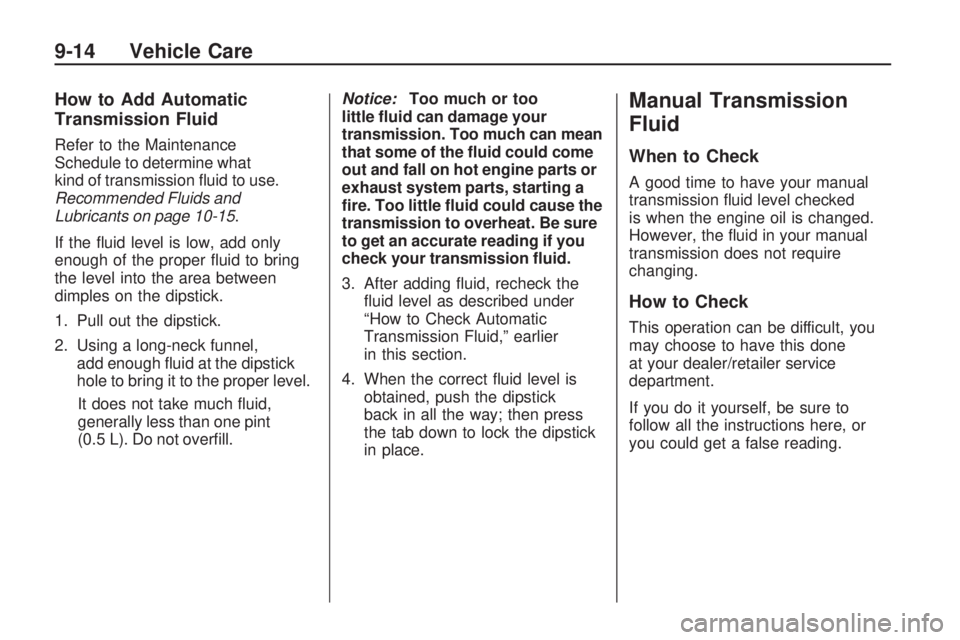
How to Add Automatic
Transmission Fluid
Refer to the Maintenance
Schedule to determine what
kind of transmission fluid to use.
Recommended Fluids and
Lubricants on page 10-15.
If the fluid level is low, add only
enough of the proper fluid to bring
the level into the area between
dimples on the dipstick.
1. Pull out the dipstick.
2. Using a long-neck funnel, add enough fluid at the dipstick
hole to bring it to the proper level.
It does not take much fluid,
generally less than one pint
(0.5 L). Do not overfill. Notice:
Too much or too
little �uid can damage your
transmission. Too much can mean
that some of the �uid could come
out and fall on hot engine parts or
exhaust system parts, starting a
�re. Too little �uid could cause the
transmission to overheat. Be sure
to get an accurate reading if you
check your transmission �uid.
3. After adding fluid, recheck the fluid level as described under
“How to Check Automatic
Transmission Fluid,” earlier
in this section.
4. When the correct fluid level is obtained, push the dipstick
back in all the way; then press
the tab down to lock the dipstick
in place.
Manual Transmission
Fluid
When to Check
A good time to have your manual
transmission fluid level checked
is when the engine oil is changed.
However, the fluid in your manual
transmission does not require
changing.
How to Check
This operation can be difficult, you
may choose to have this done
at your dealer/retailer service
department.
If you do it yourself, be sure to
follow all the instructions here, or
you could get a false reading.
9-14 Vehicle Care
Page 210 of 318
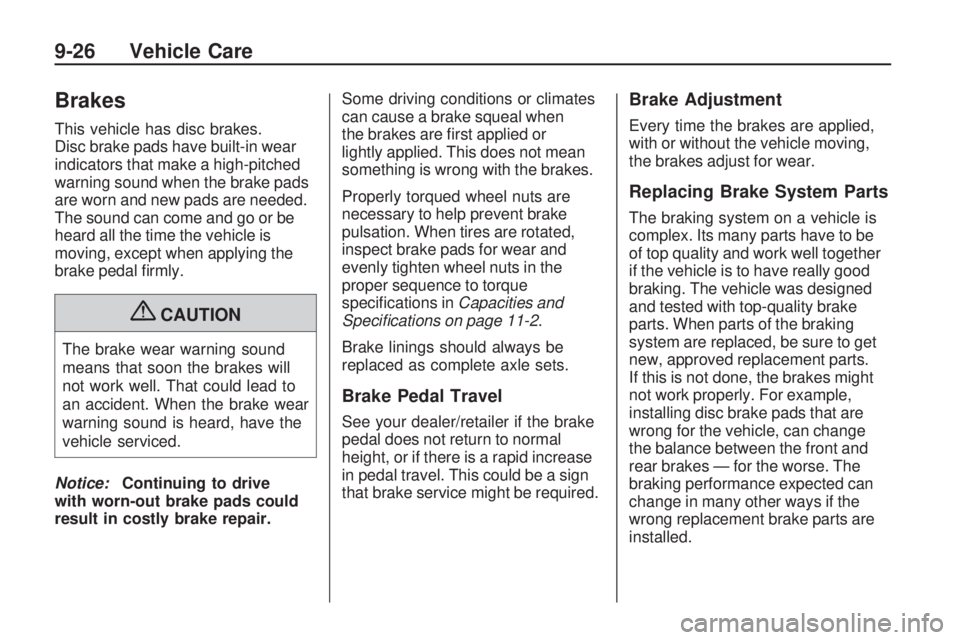
Brakes
This vehicle has disc brakes.
Disc brake pads have built-in wear
indicators that make a high-pitched
warning sound when the brake pads
are worn and new pads are needed.
The sound can come and go or be
heard all the time the vehicle is
moving, except when applying the
brake pedal firmly.
{CAUTION
The brake wear warning sound
means that soon the brakes will
not work well. That could lead to
an accident. When the brake wear
warning sound is heard, have the
vehicle serviced.
Notice: Continuing to drive
with worn-out brake pads could
result in costly brake repair. Some driving conditions or climates
can cause a brake squeal when
the brakes are first applied or
lightly applied. This does not mean
something is wrong with the brakes.
Properly torqued wheel nuts are
necessary to help prevent brake
pulsation. When tires are rotated,
inspect brake pads for wear and
evenly tighten wheel nuts in the
proper sequence to torque
specifications in
Capacities and
Speci�cations on page 11-2 .
Brake linings should always be
replaced as complete axle sets.
Brake Pedal Travel
See your dealer/retailer if the brake
pedal does not return to normal
height, or if there is a rapid increase
in pedal travel. This could be a sign
that brake service might be required.
Brake Adjustment
Every time the brakes are applied,
with or without the vehicle moving,
the brakes adjust for wear.
Replacing Brake System Parts
The braking system on a vehicle is
complex. Its many parts have to be
of top quality and work well together
if the vehicle is to have really good
braking. The vehicle was designed
and tested with top-quality brake
parts. When parts of the braking
system are replaced, be sure to get
new, approved replacement parts.
If this is not done, the brakes might
not work properly. For example,
installing disc brake pads that are
wrong for the vehicle, can change
the balance between the front and
rear brakes — for the worse. The
braking performance expected can
change in many other ways if the
wrong replacement brake parts are
installed.
9-26 Vehicle Care
Page 213 of 318
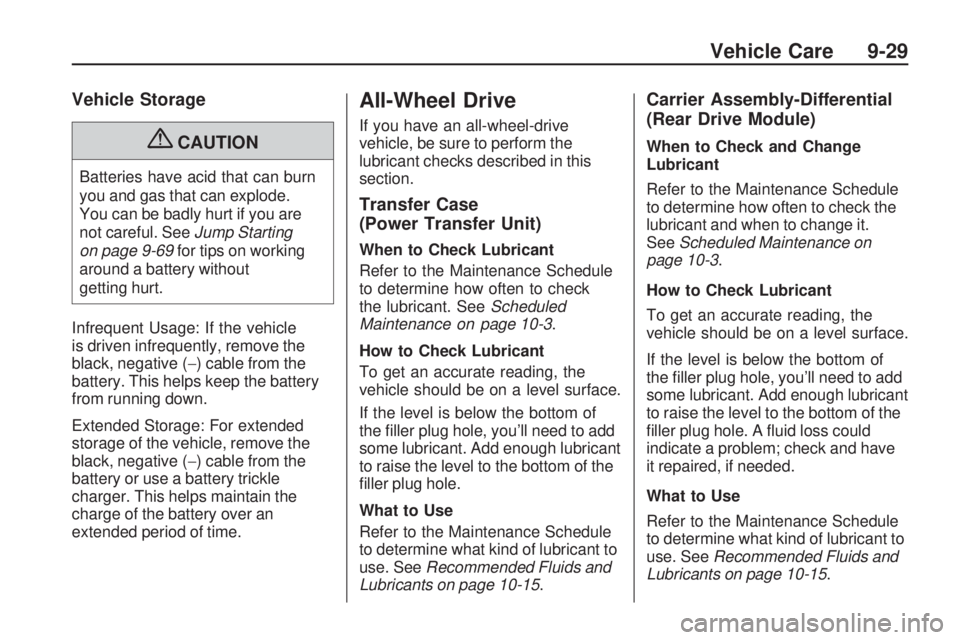
Vehicle Storage
{CAUTION
Batteries have acid that can burn
you and gas that can explode.
You can be badly hurt if you are
not careful. SeeJump Starting
on page 9-69 for tips on working
around a battery without
getting hurt.
Infrequent Usage: If the vehicle
is driven infrequently, remove the
black, negative (−) cable from the
battery. This helps keep the battery
from running down.
Extended Storage: For extended
storage of the vehicle, remove the
black, negative (−) cable from the
battery or use a battery trickle
charger. This helps maintain the
charge of the battery over an
extended period of time.
All-Wheel Drive
If you have an all-wheel-drive
vehicle, be sure to perform the
lubricant checks described in this
section.
Transfer Case
(Power Transfer Unit)
When to Check Lubricant
Refer to the Maintenance Schedule
to determine how often to check
the lubricant. See Scheduled
Maintenance on page 10-3 .
How to Check Lubricant
To get an accurate reading, the
vehicle should be on a level surface.
If the level is below the bottom of
the filler plug hole, you’ll need to add
some lubricant. Add enough lubricant
to raise the level to the bottom of the
filler plug hole.
What to Use
Refer to the Maintenance Schedule
to determine what kind of lubricant to
use. See Recommended Fluids and
Lubricants on page 10-15 .
Carrier Assembly-Differential
(Rear Drive Module)
When to Check and Change
Lubricant
Refer to the Maintenance Schedule
to determine how often to check the
lubricant and when to change it.
SeeScheduled Maintenance on
page 10-3.
How to Check Lubricant
To get an accurate reading, the
vehicle should be on a level surface.
If the level is below the bottom of
the filler plug hole, you’ll need to add
some lubricant. Add enough lubricant
to raise the level to the bottom of the
filler plug hole. A fluid loss could
indicate a problem; check and have
it repaired, if needed.
What to Use
Refer to the Maintenance Schedule
to determine what kind of lubricant to
use. See Recommended Fluids and
Lubricants on page 10-15 .
Vehicle Care 9-29
Page 266 of 318
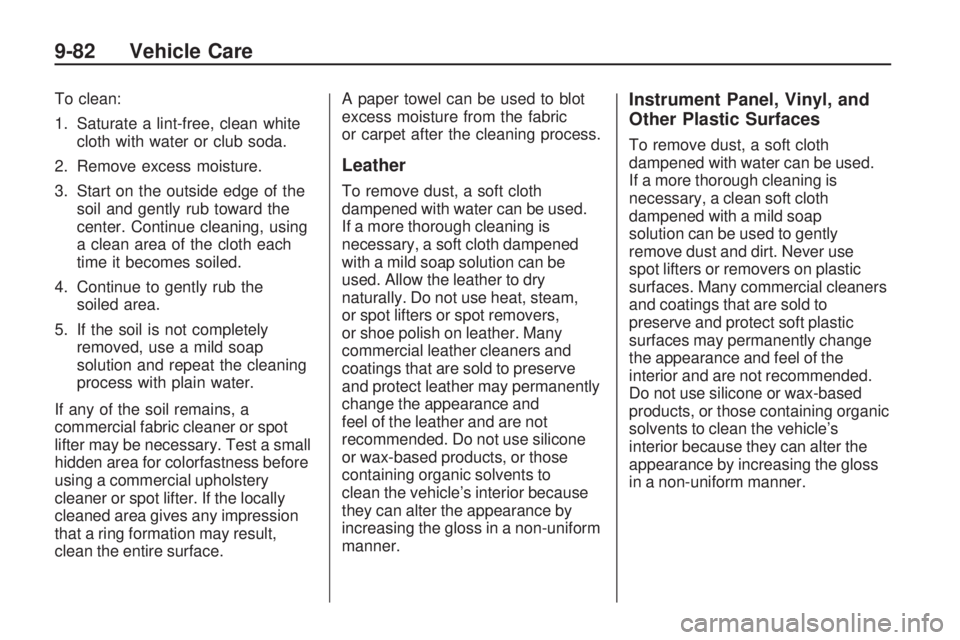
To clean:
1. Saturate a lint-free, clean whitecloth with water or club soda.
2. Remove excess moisture.
3. Start on the outside edge of the soil and gently rub toward the
center. Continue cleaning, using
a clean area of the cloth each
time it becomes soiled.
4. Continue to gently rub the soiled area.
5. If the soil is not completely removed, use a mild soap
solution and repeat the cleaning
process with plain water.
If any of the soil remains, a
commercial fabric cleaner or spot
lifter may be necessary. Test a small
hidden area for colorfastness before
using a commercial upholstery
cleaner or spot lifter. If the locally
cleaned area gives any impression
that a ring formation may result,
clean the entire surface. A paper towel can be used to blot
excess moisture from the fabric
or carpet after the cleaning process.
Leather
To remove dust, a soft cloth
dampened with water can be used.
If a more thorough cleaning is
necessary, a soft cloth dampened
with a mild soap solution can be
used. Allow the leather to dry
naturally. Do not use heat, steam,
or spot lifters or spot removers,
or shoe polish on leather. Many
commercial leather cleaners and
coatings that are sold to preserve
and protect leather may permanently
change the appearance and
feel of the leather and are not
recommended. Do not use silicone
or wax-based products, or those
containing organic solvents to
clean the vehicle’s interior because
they can alter the appearance by
increasing the gloss in a non-uniform
manner.
Instrument Panel, Vinyl, and
Other Plastic Surfaces
To remove dust, a soft cloth
dampened with water can be used.
If a more thorough cleaning is
necessary, a clean soft cloth
dampened with a mild soap
solution can be used to gently
remove dust and dirt. Never use
spot lifters or removers on plastic
surfaces. Many commercial cleaners
and coatings that are sold to
preserve and protect soft plastic
surfaces may permanently change
the appearance and feel of the
interior and are not recommended.
Do not use silicone or wax-based
products, or those containing organic
solvents to clean the vehicle’s
interior because they can alter the
appearance by increasing the gloss
in a non-uniform manner.
9-82 Vehicle Care
Page 269 of 318
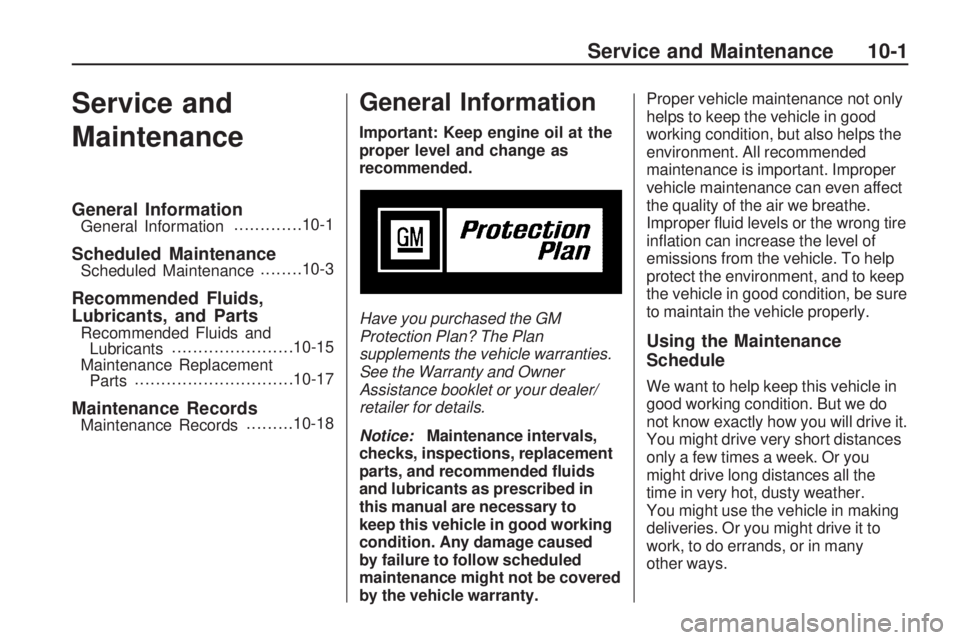
Service and
Maintenance
General InformationGeneral Information.............10-1
Scheduled MaintenanceScheduled Maintenance ........10-3
Recommended Fluids,
Lubricants, and Parts
Recommended Fluids and
Lubricants ......................
.10-15
Maintenance Replacement Parts .............................
.10-17
Maintenance RecordsMaintenance Records .........10-18
General Information
Important: Keep engine oil at the
proper level and change as
recommended.
Have you purchased the GM
Protection Plan? The Plan
supplements the vehicle warranties.
See the Warranty and Owner
Assistance booklet or your dealer/
retailer for details.
Notice:
Maintenance intervals,
checks, inspections, replacement
parts, and recommended �uids
and lubricants as prescribed in
this manual are necessary to
keep this vehicle in good working
condition. Any damage caused
by failure to follow scheduled
maintenance might not be covered
by the vehicle warranty. Proper vehicle maintenance not only
helps to keep the vehicle in good
working condition, but also helps the
environment. All recommended
maintenance is important. Improper
vehicle maintenance can even affect
the quality of the air we breathe.
Improper fluid levels or the wrong tire
inflation can increase the level of
emissions from the vehicle. To help
protect the environment, and to keep
the vehicle in good condition, be sure
to maintain the vehicle properly.
Using the Maintenance
Schedule
We want to help keep this vehicle in
good working condition. But we do
not know exactly how you will drive it.
You might drive very short distances
only a few times a week. Or you
might drive long distances all the
time in very hot, dusty weather.
You might use the vehicle in making
deliveries. Or you might drive it to
work, to do errands, or in many
other ways.
Service and Maintenance 10-1
Page 271 of 318
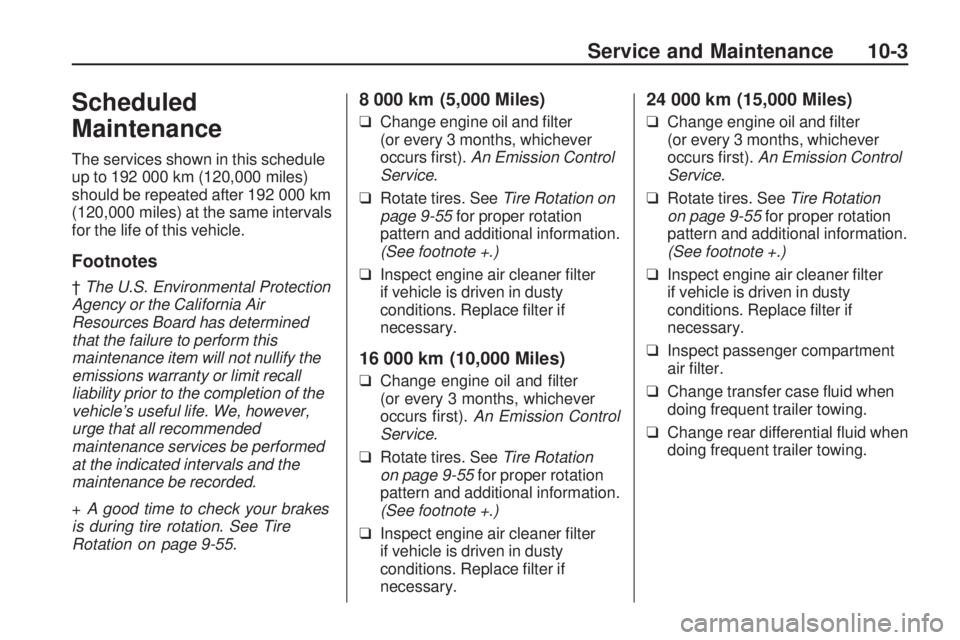
Scheduled
Maintenance
The services shown in this schedule
up to 192 000 km (120,000 miles)
should be repeated after 192 000 km
(120,000 miles) at the same intervals
for the life of this vehicle.
Footnotes
†The U.S. Environmental Protection
Agency or the California Air
Resources Board has determined
that the failure to perform this
maintenance item will not nullify the
emissions warranty or limit recall
liability prior to the completion of the
vehicle’s useful life. We, however,
urge that all recommended
maintenance services be performed
at the indicated intervals and the
maintenance be recorded.
+ A good time to check your brakes
is during tire rotation. See Tire
Rotation on page 9-55 .
8 000 km (5,000 Miles)
❑Change engine oil and filter
(or every 3 months, whichever
occurs first). An Emission Control
Service.
❑ Rotate tires. See Tire Rotation on
page 9-55 for proper rotation
pattern and additional information.
(See footnote +.)
❑ Inspect engine air cleaner filter
if vehicle is driven in dusty
conditions. Replace filter if
necessary.
16 000 km (10,000 Miles)
❑ Change engine oil and filter
(or every 3 months, whichever
occurs first). An Emission Control
Service.
❑ Rotate tires. See Tire Rotation
on page 9-55 for proper rotation
pattern and additional information.
(See footnote +.)
❑ Inspect engine air cleaner filter
if vehicle is driven in dusty
conditions. Replace filter if
necessary.
24 000 km (15,000 Miles)
❑ Change engine oil and filter
(or every 3 months, whichever
occurs first). An Emission Control
Service.
❑ Rotate tires. See Tire Rotation
on page 9-55 for proper rotation
pattern and additional information.
(See footnote +.)
❑ Inspect engine air cleaner filter
if vehicle is driven in dusty
conditions. Replace filter if
necessary.
❑ Inspect passenger compartment
air filter.
❑ Change transfer case fluid when
doing frequent trailer towing.
❑ Change rear differential fluid when
doing frequent trailer towing.
Service and Maintenance 10-3
Page 298 of 318
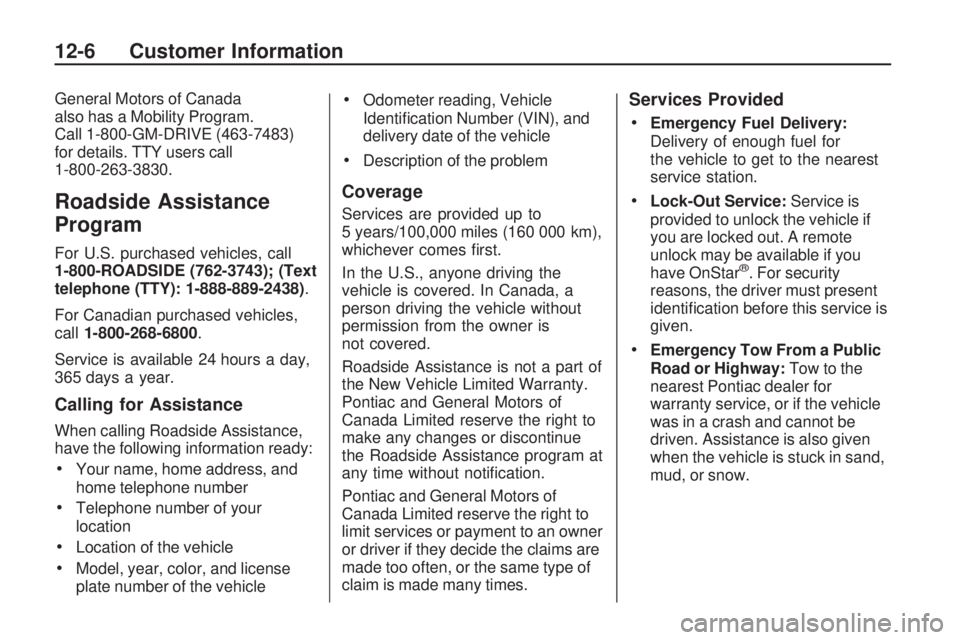
General Motors of Canada
also has a Mobility Program.
Call 1-800-GM-DRIVE (463-7483)
for details. TTY users call
1-800-263-3830.
Roadside Assistance
Program
For U.S. purchased vehicles, call
1-800-ROADSIDE (762-3743); (Text
telephone (TTY): 1-888-889-2438).
For Canadian purchased vehicles,
call 1-800-268-6800 .
Service is available 24 hours a day,
365 days a year.
Calling for Assistance
When calling Roadside Assistance,
have the following information ready:
•Your name, home address, and
home telephone number
•Telephone number of your
location
•Location of the vehicle
•Model, year, color, and license
plate number of the vehicle
•Odometer reading, Vehicle
Identification Number (VIN), and
delivery date of the vehicle
•Description of the problem
Coverage
Services are provided up to
5 years/100,000 miles (160 000 km),
whichever comes first.
In the U.S., anyone driving the
vehicle is covered. In Canada, a
person driving the vehicle without
permission from the owner is
not covered.
Roadside Assistance is not a part of
the New Vehicle Limited Warranty.
Pontiac and General Motors of
Canada Limited reserve the right to
make any changes or discontinue
the Roadside Assistance program at
any time without notification.
Pontiac and General Motors of
Canada Limited reserve the right to
limit services or payment to an owner
or driver if they decide the claims are
made too often, or the same type of
claim is made many times.
Services Provided •
Emergency Fuel Delivery:
Delivery of enough fuel for
the vehicle to get to the nearest
service station.
•Lock-Out Service: Service is
provided to unlock the vehicle if
you are locked out. A remote
unlock may be available if you
have OnStar
®. For security
reasons, the driver must present
identification before this service is
given.
•Emergency Tow From a Public
Road or Highway: Tow to the
nearest Pontiac dealer for
warranty service, or if the vehicle
was in a crash and cannot be
driven. Assistance is also given
when the vehicle is stuck in sand,
mud, or snow.
12-6 Customer Information
Page 301 of 318

Public Transportation or Fuel
Reimbursement
If your vehicle requires overnight
warranty repairs, and public
transportation is used instead of
the dealer’s shuttle service, the
expense must be supported by
original receipts and can only be up
to the maximum amount allowed by
GM for shuttle service. In addition,
for U.S. customers, should you
arrange transportation through
a friend or relative, limited
reimbursement for reasonable
fuel expenses may be available.
Claim amounts should reflect actual
costs and be supported by original
receipts. See your dealer for
information regarding the allowance
amounts for reimbursement of fuel
or other transportation costs.Courtesy Rental Vehicle
Your dealer may arrange to provide
you with a courtesy rental vehicle or
reimburse you for a rental vehicle
that you obtain if your vehicle is kept
for an overnight warranty repair.
Rental reimbursement will be limited
and must be supported by original
receipts. This requires that you sign
and complete a rental agreement
and meet state/provincial, local,
and rental vehicle provider
requirements. Requirements vary
and may include minimum age
requirements, insurance coverage,
credit card, etc. You are responsible
for fuel usage charges and may also
be responsible for taxes, levies,
usage fees, excessive mileage, or
rental usage beyond the completion
of the repair.
It may not be possible to provide a
like-vehicle as a courtesy rental.Additional Program
Information
All program options, such as shuttle
service, may not be available at
every dealer. Please contact your
dealer for specific information
about availability. All Courtesy
Transportation arrangements will
be administered by appropriate
dealer personnel.
General Motors reserves the right
to unilaterally modify, change or
discontinue Courtesy Transportation
at any time and to resolve all
questions of claim eligibility pursuant
to the terms and conditions
described herein at its sole
discretion.
Customer Information 12-9
Page 305 of 318

Current and Past Model Order
Forms
Technical Service Bulletins and
Manuals are available for current
and past model GM vehicles.
To request an order form, specify
year and model name of the vehicle.
ORDER TOLL FREE:
1-800-551-4123 Monday-Friday
8:00 AM - 6:00 PM Eastern Time
For Credit Card Orders Only
(VISA-MasterCard-Discover), visit
Helm, Inc. on the World Wide
Web at: helminc.com
Or you can write to:
Helm, Incorporated
P.O. Box 07130
Detroit, MI 48207
Prices are subject to change
without notice and without incurring
obligation. Allow ample time for
delivery.
Note to Canadian Customers: All
listed prices are quoted in U.S.
funds. Canadian residents are to
make checks payable in U.S. funds.
Reporting Safety
Defects
Reporting Safety Defects
to the United States
Government
If you believe that your vehicle
has a defect which could cause
a crash or could cause injury or
death, you should immediately
inform the National Highway
Traffic Safety Administration
(NHTSA) in addition to notifying
General Motors.
If NHTSA receives similar
complaints, it may open an
investigation, and if it finds that a
safety defect exists in a group of
vehicles, it may order a recall and
remedy campaign. However,
NHTSA cannot become involved
in individual problems between
you, your dealer/retailer, or
General Motors.To contact NHTSA, you may
call the Vehicle Safety Hotline
toll-free at 1-888-327-4236
(TTY: 1-800-424-9153); go to
safercar.gov; or write to:
Administrator, NHTSA
1200 New Jersey Avenue, S.E.
Washington D.C., 20590
You can also obtain other
information about motor vehicle
safety from safercar.gov.
Reporting Safety Defects
to the Canadian
Government
If you live in Canada, and you
believe that your vehicle has a safety
defect, notify Transport Canada
immediately, in addition to notifying
General Motors of Canada Limited.
Call them at 1-800-333-0510 or
write to:
Transport Canada
Road Safety Branch
2780 Sheffield Road
Ottawa, Ontario K1B 3V9
Customer Information 12-13
Page 313 of 318
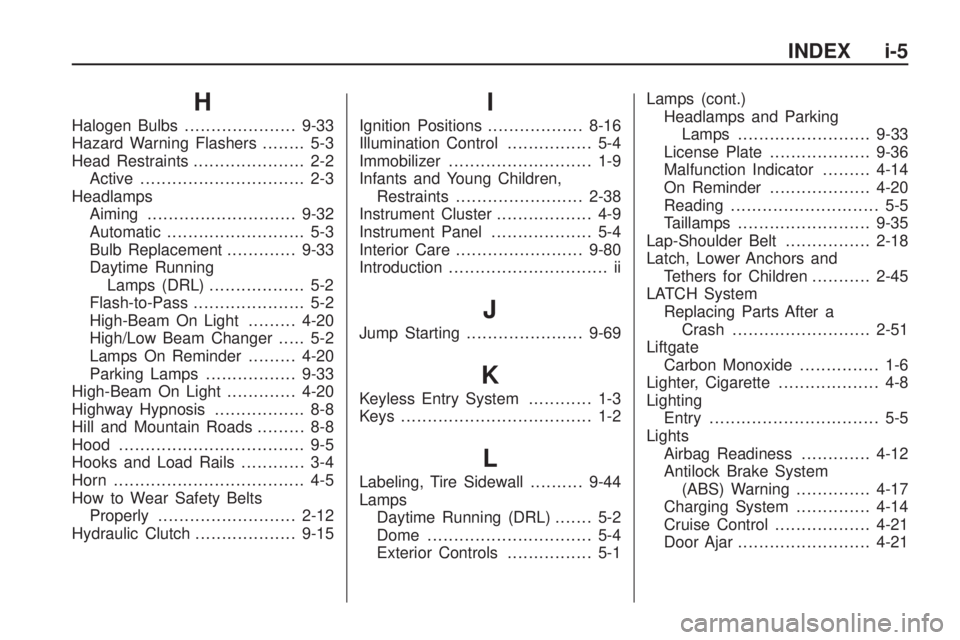
H
Halogen Bulbs..................... 9-33
Hazard Warning Flashers ........ 5-3
Head Restraints ..................... 2-2
Active ............................... 2-3
Headlamps Aiming ............................ 9-32
Automatic .......................... 5-3
Bulb Replacement .............9-33
Daytime Running Lamps (DRL) .................. 5-2
Flash-to-Pass ..................... 5-2
High-Beam On Light .........4-20
High/Low Beam Changer ..... 5-2
Lamps On Reminder .........4-20
Parking Lamps .................9-33
High-Beam On Light .............4-20
Highway Hypnosis ................. 8-8
Hill and Mountain Roads ......... 8-8
Hood ................................... 9-5
Hooks and Load Rails ............ 3-4
Horn .................................... 4-5
How to Wear Safety Belts Properly .......................... 2-12
Hydraulic Clutch ...................9-15
I
Ignition Positions ..................8-16
Illumination Control ................ 5-4
Immobilizer ........................... 1-9
Infants and Young Children, Restraints ........................ 2-38
Instrument Cluster .................. 4-9
Instrument Panel ................... 5-4
Interior Care ........................ 9-80
Introduction .............................. ii
J
Jump Starting ...................... 9-69
K
Keyless Entry System ............ 1-3
Keys .................................... 1-2
L
Labeling, Tire Sidewall ..........9-44
Lamps Daytime Running (DRL) ....... 5-2
Dome ............................... 5-4
Exterior Controls ................ 5-1 Lamps (cont.)
Headlamps and ParkingLamps ......................... 9-33
License Plate ................... 9-36
Malfunction Indicator .........4-14
On Reminder ................... 4-20
Reading ............................ 5-5
Taillamps ......................... 9-35
Lap-Shoulder Belt ................2-18
Latch, Lower Anchors and Tethers for Children ...........2-45
LATCH System Replacing Parts After aCrash .......................... 2-51
Liftgate Carbon Monoxide ............... 1-6
Lighter, Cigarette ................... 4-8
Lighting Entry ................................ 5-5
Lights Airbag Readiness .............4-12
Antilock Brake System (ABS) Warning ..............4-17
Charging System ..............4-14
Cruise Control ..................4-21
Door Ajar ......................... 4-21
INDEX i-5